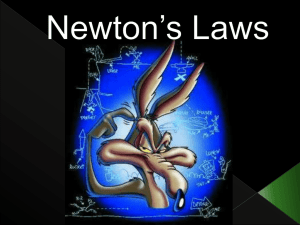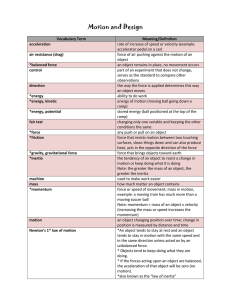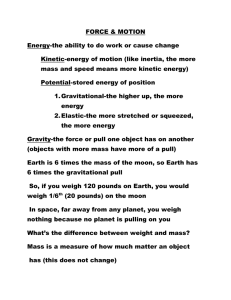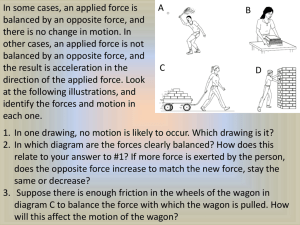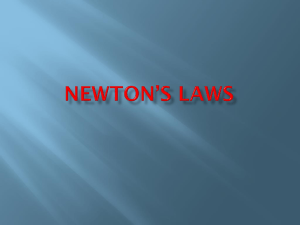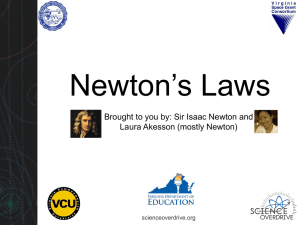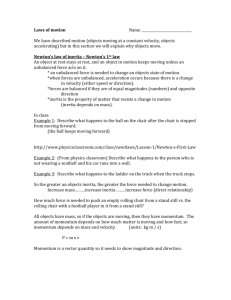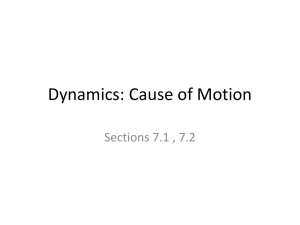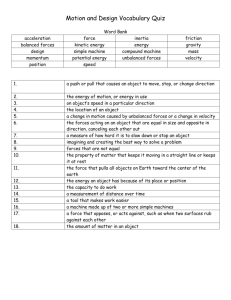Newton`s 2 nd Law of Motion Force = Mass x Acceleration
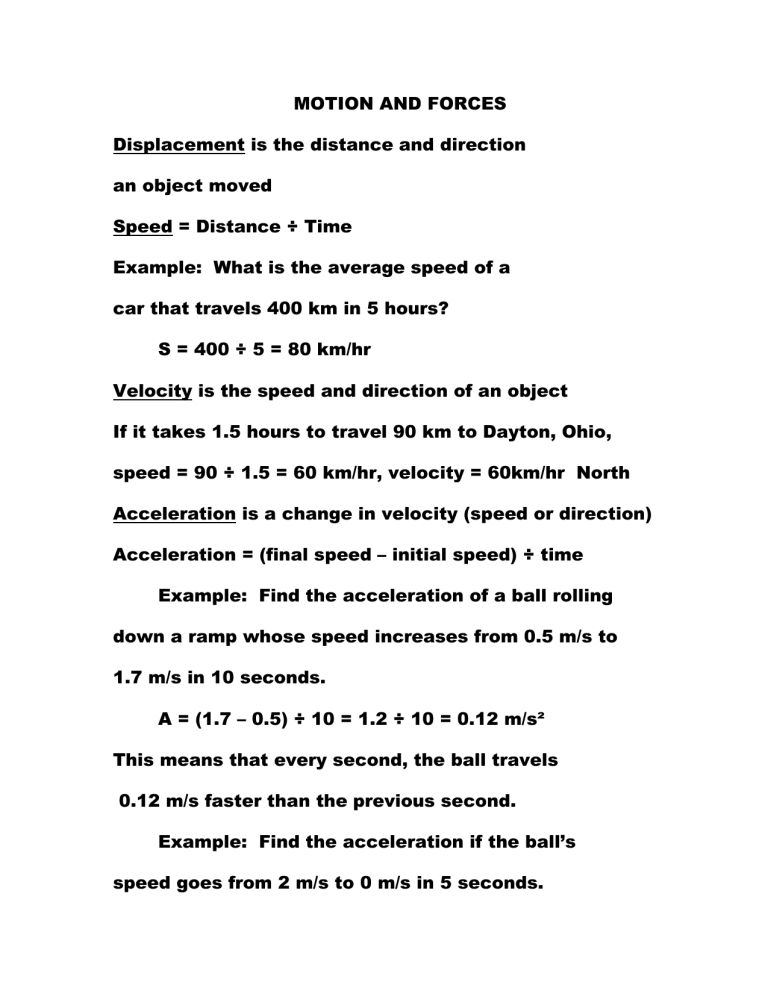
MOTION AND FORCES
Displacement is the distance and direction an object moved
Speed = Distance ÷ Time
Example: What is the average speed of a car that travels 400 km in 5 hours?
S = 400 ÷ 5 = 80 km/hr
Velocity is the speed and direction of an object
If it takes 1.5 hours to travel 90 km to Dayton, Ohio, speed = 90 ÷ 1.5 = 60 km/hr, velocity = 60km/hr North
Acceleration is a change in velocity (speed or direction)
Acceleration = (final speed – initial speed) ÷ time
Example: Find the acceleration of a ball rolling down a ramp whose speed increases from 0.5 m/s to
1.7 m/s in 10 seconds.
A = (1.7 – 0.5) ÷ 10 = 1.2 ÷ 10 = 0.12 m/s²
This means that every second, the ball travels
0.12 m/s faster than the previous second.
Example: Find the acceleration if the ball’s speed goes from 2 m/s to 0 m/s in 5 seconds.
A = (0 – 2) ÷ 5 = -2 ÷ 5 = -0.4 m/s² (ball is slowing down)
Gravity-the force or pull one object has on another
(objects with more mass have more of a pull)
Earth is 6 times the mass of the moon, so
Earth has 6 times the gravitational pull
So, if you weigh 120 pounds on Earth, you would weigh 1/6 th (20 pounds) on the moon
In space, far away from any planet, you weigh nothing because no planet is pulling on you
What’s the difference between weight and mass?
Mass is a measure of how much matter an object has (this does not change)
Weight is mass times the gravity acting on an object (this changes based upon the mass of the planet or moon you are near)
Inertia-the tendency of an object to resist changes in motion
*The more mass an object has, the more inertia it has
*The more speed , the more inertia
Force-anything that causes an object to change speed or direction
Friction-a force that resists motion between 2 objects in contact (Air resistance is an example)
Newton’s 1 st Law of Motion-an object remains at rest or in motion unless acted on by a force
Momentum-when an object is in motion, it has momentum
*The greater the mass, the greater the momentum.
*The faster an object is moving, the greater the momentum.
Momentum = velocity x mass
Example: How much momentum does a 200 kg motorcycle have if it is traveling 15m/s?
Mo = 15 x 200 = 3000 kg·m/s
Newton’s 2 nd Law of Motion Force = Mass x
Acceleration
Example: How much force does it take to accelerate a 7 kg wagon at 3m/s²?
F = M x A, F = 7 x 3 = 21 Newtons (N)
Balanced Forces-act against each other (no movement)
Unbalanced Forces-cause an object to move
Net Force-the total force acting on an object
**If Jane pushes a wagon East with a force of 70
Newtons and Dave pushes it West with a force of
50 Newtons, what is the net force?
70 – 50 = 20 Newtons East (the forces are unbalanced)
**If Jim pushes on a table with 250 N of force and the table’s frictional force with the floor is 60 N, what is the net force?
250 – 60 = 190 N (unbalanced)
**If the net force is zero it means all forces are balanced and the object does not move!!
Work = force x distance (Units are in Joules)
Example: How much work is done to lift a 20
Newton box up 3 meters?
W = F x D = 20 x 3 = 60 J
Energy-the ability to do work or cause change
Kinetic-energy of motion (like inertia, the more mass and speed means more kinetic energy)
Potential-stored energy of position
1.
Gravitational-the higher up, the more energy
2.
Elastic-the more stretched or squeezed, the more energy
Simple Machines do not change the amount of work being done, they just make it easier.
How? By spreading it out
Newton’s 3 rd Law of Motion-For every action there is an equal and opposite reaction.
Examples:
1.
A fish pushes its fins against water and the water pushes back, so the fish moves forward
2.
A water hose moves backward as water goes out of hose
3.
A bullet comes out of a gun and the gun kicks back

